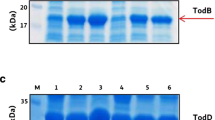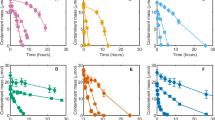Abstract
Toluene dioxygenase (TDO) is ubiquitous in nature and has a broad substrate range, including benzene, toluene, ethylbenzene and xylenes (BTEX). Pseudomonas putida F1 (PpF1) induced on toluene is known to produce indigo from indole through the activity of TDO. In this work, a spectrophotometric assay previously developed to measure indole to indigo production rates was modified to characterize the effects of various ethanol concentrations on toluene aerobic biodegradation activity and assess catabolite repression of TDO. Indigo production rate by cells induced on toluene alone was 0.0012 ± 0.0006 OD610 min−1. The presence of ethanol did not fully repress TDO activity when toluene was also available as a carbon source. However, indigo production rates by PpF1 grown on ethanol:toluene mixtures (3:1 w/w) decreased by approximately 50%. Overall, the proposed spectrophotometric assay is a simple approach to quantify TDO activity, and demonstrates how the presence of ethanol in groundwater contaminated with reformulated gasoline is likely to interfere with naturally occurring microorganisms from fully expressing their aerobic catabolic potential towards hydrocarbons bioremediation.


Similar content being viewed by others
References
Alvarez PJJ, Vogel TM (1991) Substrate interactions of benzene, toluene, and para-xylene during microbial-degradation by pure cultures and mixed culture aquifer slurries. Appl Environ Microbiol 57(10):2981–2985
Button DK (1985) Kinetics of nutrient-limited transport and microbial-growth. Microbiol Rev 49(3):270–297
Corseuil HX, Hunt CS, Dos Santos RCF, Alvarez PJJ (1998) The influence of the gasoline oxygenate ethanol on aerobic and anaerobic BTX biodegradation. Water Res 32(7):2065–2072
Costura RK, Alvarez PJJ (2000) Expression and longevity of toluene dioxygenase in Pseudomonas putida F1 induced at different dissolved oxygen concentrations. Water Res 34(11):3014–3018
Dorn JG, Frye RJ, Maier RM (2003) Effect of temperature, pH, and initial cell number on luxCDABE and nah gene expression during naphthalene and salicylate catabolism in the bioreporter organism Pseudomonas putida RB1353. Appl Environ Microbiol 69(4):2209–2216
Duetz WA, Dejong C, Williams PA, Vanandel JG (1994a) Competition in chemostat culture between Pseudomonas strains that use different pathways for the degradation of toluene. Appl Environ Microbiol 60(8):2858–2863
Duetz WA, Marques S, Dejong C, Ramos JL, Vanandel JG (1994b) Inducibility of the Tol catabolic pathway in Pseudomonas putida (Pww0) growing on succinate in continuous-culture—evidence of carbon catabolite repression control. J Bacteriol 176(8):2354–2361
Egli T (1995) The ecological and physiological significance of the growth of heterotrophic microorganisms with mixtures of substrates. Adv Microb Ecol 14:305–386
Egli T, Käppeli O, Fiechter A (1982) Regulatory flexibility of methylotrophic yeasts in chemostat cultures: simultaneous assimilation of glucose and methanol at a fixed dilution rate. Arch Microbiol 131:1–7
Egli T, Lindley ND, Quayle JR (1983) Regulation of enzyme synthesis and variation of residual methanol concentration during carbon-limited growth of Kloeckera sp. 2201 on mixtures of methanol and glucose. J Gen Microbiol 129:1269–1281
Egli T, Lendenmann U, Snozzi M (1993) Kinetics of microbial growth with mixtures of carbon sources. Antonie van Leeuwenhoek 63:289–298
Ensley BD, Gibson DT (1983) Naphthalene dioxygenase—purification and properties of a terminal oxygenase component. J Bacteriol 155(2):505–511
Finette BA, Subramanian V, Gibson DT (1984) Isolation and characterization of Pseudomonas putida Ppf1 mutants defective in the toluene dioxygenase enzyme-system. J Bacteriol 160(3):1003–1009
Gibson DT, Parales RE (2000) Aromatic hydrocarbon dioxygenases in environmental biotechnology. Curr Opin Biotechnol 11(3):236–243
Heitzer A, Applegate B, Kehrmeyer S, Pinkart H, Webb OF, Phelps TJ, White DC, Sayler GS (1998) Physiological considerations of environmental applications of lux reporter fusions. J Microbiol Methods 33(1):45–57
Hunt CS, Cronkhite LA, Corseuil HX, Alvarez PJJ (1997) Effect of ethanol on anaerobic toluene degradation in aquifer microcosms. Abstr Pap Am Chem Soc 213:243
Lau PCK, Bergeron H, Labbe D, Wang Y, Brousseau R, Gibson DT (1994) Sequence and expression of the tod gih genes involved in the last 3 steps of toluene degradation by Pseudomonas putida F1. Gene 146(1):7–13
Lovanh N, Alvarez PJJ (2004) Effect of ethanol, acetate, and phenol on toluene degradation activity and tod-lux expression in Pseudomonas putida TOD102: an evaluation of the metabolic flux dilution model. Biotechnol Bioeng 86(7):801–808
Lovanh N, Hunt CS, Alvarez PJJ (2002) Effect of ethanol on BTEX biodegradation kinetics: aerobic continuous culture experiments. Water Res 36(15):3739–3746
Madigan MT, Martinko JM, Parker J (1997) Brock biology of microorganisms. Prentice Hall, United States
Mermod N, Ramos JL, Lehrbach PR, Timmis KN (1986) Vector for regulated expression of cloned genes in a wide range of gram-negative bacteria. J Bacteriol 167(2):447–454
Murdock D, Ensley BD, Serdar C, Thalen M (1993) Construction of metabolic operons catalyzing the denovo biosynthesis of indigo in Escherichia coli. Biotechnology 11(3):381–386
Neilson JW, Pierce SA, Maier RM (1999) Factors influencing expression of luxCDABE and nah genes in Pseudomonas putida RB1353 (NAH7, pUTK9) in dynamic systems. Appl Environ Microbiol 65(8):3473–3482
O’Connor KE, Dobson ADW, Hartmans S (1997) Indigo formation by microorganisms expressing styrene monooxygenase activity. Appl Environ Microbiol 63(11):4287–4291
Robertson BR, Button DK (1987) Toluene induction and uptake kinetics and their inclusion in the specific affinity relationship for describing rates of hydrocarbon metabolism. Appl Environ Microbiol 53(9):2193–2205
Ruiz-Aguilar GML, Fernandez-Sanchez JM, Kane SR, Kim D, Alvarez PJJ (2002) Effect of ethanol and methyl-tert-butyl ether on monoaromatic hydrocarbon biodegradation: response variability for different aquifer materials under various electron-accepting conditions. Environ Toxicol Chem 21(12):2631–2639
Wackett LP, Kwart LD, Gibson DT (1988) Benzylic monooxygenation catalyzed by toluene dioxygenase from Pseudomonas putida. Biochemistry 27(4):1360–1367
Woo HJ, Sanseverino J, Cox CD, Robinson KG, Sayler GS (2000) The measurement of toluene dioxygenase activity in biofilm culture of Pseudomonas putida F1. J Microbiol Methods 40(2):181–191
Zylstra GJ, McCombie WR, Gibson DT, Finette BA (1988) Toluene degradation by Pseudomonas putida F1—genetic organization of the tod operon. Appl Environ Microbiol 54(6):1498–1503
Zylstra GJ, Wackett LP, Gibson DT (1989) Trichloroethylene degradation by Escherichia coli containing the cloned Pseudomonas putida F1 toluene dioxygenase genes. Appl Environ Microbiol 55(12):3162–3166
Author information
Authors and Affiliations
Corresponding author
Rights and permissions
About this article
Cite this article
da Silva, M.L.B., Alvarez, P.J.J. Indole-based assay to assess the effect of ethanol on Pseudomonas putida F1 dioxygenase activity. Biodegradation 21, 425–430 (2010). https://doi.org/10.1007/s10532-009-9312-9
Received:
Accepted:
Published:
Issue Date:
DOI: https://doi.org/10.1007/s10532-009-9312-9




